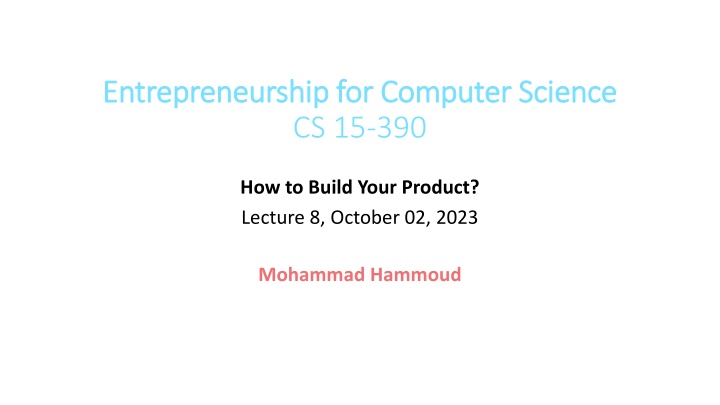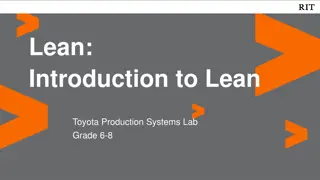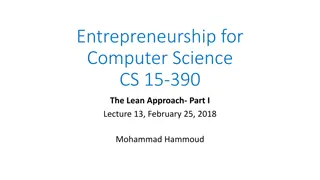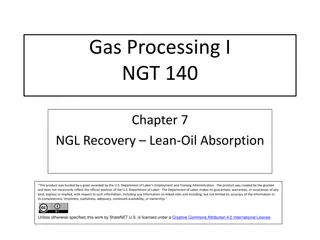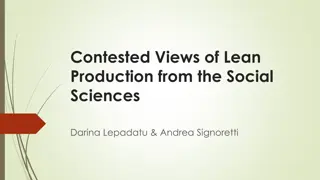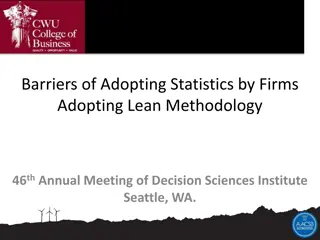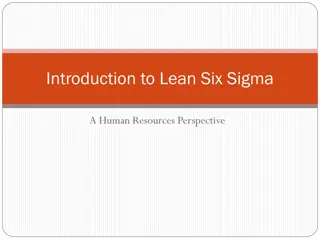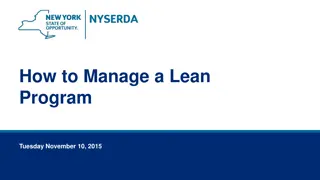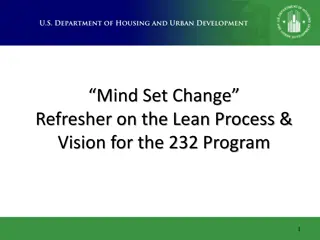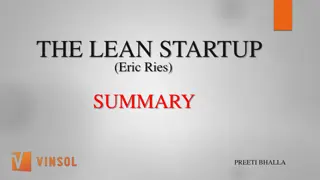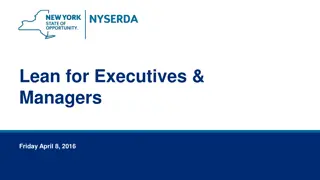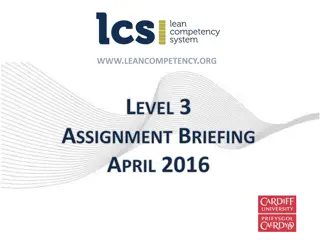Lean Approach for Building Successful Products
In entrepreneurship, the focus is on creating value for customers through lean thinking and continuous alignment with real needs. The process involves identifying market opportunities, building prototypes, and iterating based on customer feedback to ensure product-market fit. By employing a build-experiment-learn feedback loop, entrepreneurs can enhance their chances of delivering products that customers will use and value.
Download Presentation

Please find below an Image/Link to download the presentation.
The content on the website is provided AS IS for your information and personal use only. It may not be sold, licensed, or shared on other websites without obtaining consent from the author.If you encounter any issues during the download, it is possible that the publisher has removed the file from their server.
You are allowed to download the files provided on this website for personal or commercial use, subject to the condition that they are used lawfully. All files are the property of their respective owners.
The content on the website is provided AS IS for your information and personal use only. It may not be sold, licensed, or shared on other websites without obtaining consent from the author.
E N D
Presentation Transcript
Entrepreneurship for Computer Science Entrepreneurship for Computer Science CS 15-390 How to Build Your Product? Lecture 8, October 02, 2023 Mohammad Hammoud
Today Last Lecture: Project presentations Today s Lecture: The lean approach for building a product Announcements: Student presentations are on Oct 04 Report 3 is due on Oct 04 by midnight (rubric will be shared today on Piazza) Midterm exam will be on Oct 18 (all materials are included)
Entrepreneurship Paradigm A System of Functions Paradigm: Functions Identify & Research a Market Found or Co-found a Company Build a Business Model Identify a Problem Build a Prototype Bootstrap and/or Raise Angle Fund Raise Market & Operate Build a Culture Build an MVP Professional Money Scale Exit
Entrepreneurship Paradigm A System of Functions Paradigm: Functions Identify & Research a Market Found or Co-found a Company Build a Business Model Identify a Problem Build a Prototype Bootstrap and/or Raise Angle Fund Raise Market & Operate Build a Culture Build an MVP Professional Money Scale Exit
Lean Thinking Which of our development efforts will create value and which will not? The lean thinking defines value-creation as providing benefit to your (target) customers; anything else is a waste! But how can you know whether you are providing benefit to your customers while you are developing your product (before you launch it)? True startup productivity cannot be measured in terms of how much you are building every day, but rather how much you are building everyday that your customers will use
Towards Value Creation Success is not about delivering a product but delivering a product that customers will use The way to do this is to continuously align your efforts with your customers real needs Recall principle 4: Don t Ask, but Show People What they Want Hence, this alignment process is not about asking your customers what they need because they typically do not know what they need The build-experiment-learnfeedback loopallows you to identify your customers needs and calibrate your development efforts accordingly
Build-Experiment-Learn Feedback Loop Idea Learn Build Data Product Experiment
Build-Experiment-Learn Feedback Loop Idea Learn Build Data Product Experiment
The Build Phase: MVP The build phase can be entered as quickly as possible with a Minimum Viable Product (MVP) An MVP ranges in complexity from extremely simple smoke tests (little more than an advertisement) to launchable products Smoke Test Launchable Product A product with missing features and potentially some issues No product is built yet!
An MVP Example: Dropbox Dropbox is an easy-to-use file sharing technology, which uses a push- based caching (or full replication) technique Push immediately to Dropbox servers Push immediately to all sharing devices
An MVP Example: Dropbox Dropbox requires integration with a variety of computer platforms and OSs: Windows, Macintosh, iPhone, Android, and so on It also necessitates deep distributed systems expertise (caching, replication, consistency, reliability, availability, etc.,) To avoid the risk of waking up after years of development with a product that nobody wanted, Drew Houston (Founder & CEO of Dropbox) did something unexpectedly easy He made a video!
An MVP Example: Dropbox The video was a 3-minute demonstration of the technology as it is meant to work It was narrated by Drew himself (it was really banal!) It targeted early adopters, who do not need a perfect solution to get intrigued LATE MAJORITY conservatives The Technology Adoption Life Cycle THE CHASM INNOVATORS techies EARLY MAJORITY pragmatists LAGGARDS skeptics EARLY ADOPTERS visionaries
An MVP Example: Dropbox The video was a 3-minute demonstration of the technology as it is meant to work It was narrated by Drew himself (it was really banal!) It targeted early adopters, who do not need a perfect solution to get intrigued Drew recounted: It drove hundreds of thousands of people to the website. Our beta waiting list went from 5,000 people to 75,000 people literally overnight. It totally blew us away. Today, Dropbox is worth more than $10 billion
The Build Phase: MVP Deciding how complex an MVP cannot be done formulaically It requires judgment! When in doubt, simplify Avoid overbuilding and overpromising Any additional work beyond what needs to get you starting the loop might be a waste An MVP does not only speak to product design and technical questions, but also to fundamental business hypotheses It provides a needed dose of reality It often results in seemingly bad (but actually good!) news
Build-Experiment-Learn Feedback Loop Idea Learn Build Data Product Experiment
Build-Experiment-Learn Feedback Loop Idea Learn Build Data Product Experiment
Leap-of-Faith Assumptions The riskiest elements of a startup s plan (i.e., the parts on which everything depends) are called leap-of-faith assumptions E.g., What was the main leap-of-faith assumption of Dropbox? File sharing is a need and file synchronization is a problem Note: Most people do not know about a certain solution, but once they experience it, they cannot imagine how they ever lived without it!
Leap-of-Faith Assumptions The two most important assumptions of any startup are the value and growth hypotheses The value hypothesis: Is the product delivering value to customers after they start using it? Key Performance Indicator (KPI): Retention Rate The growth hypothesis: How did the new customers know about the product? KPI: Referral Rate
Example: Meta In 2004, Facebook (now Meta) had 150,000 registered users with very little revenue Yet, that summer it raised its first $500,000 in venture capital Less than a year later, it raised an additional $12.7 million How was Facebook able to raise so much money when its revenue was so little?
Example: Meta This has to do with Facebook s value and growth hypotheses: Value hypothesis: More than half of the users came back to the site every single day Retention Rate > 50% (hypothesis is validated) Growth hypothesis: Facebook launched on Feb 4, 2004, and by the end of that month, almost of Harvard s undergraduates were using it (without spending a dollar on marketing or advertising!) Referral Rate was exponential (hypothesis is validated)
Experimenting: Aardvark Google excels at answering factual questions What is the tallest mountain in the world? Who was the twenty third president of United States? However, Google struggles with answering subjective questions What is a good place to go out with a friend after a football game in my city? Subjective questions are relatively easy for a person to answer Imagine you re at a cocktail party surrounded by friends; how likely would it be to get a good answer for your subjective question? Very high!
Experimenting: Aardvark To technically solve this problem, Max Ventilla and Damon Horowitz created a product called Aardvark They built a very basic prototype with an instant messaging (IM) front- end and a human-driven back-end (NOT an AI-based engine) A customer can send Aardvark questions via the IM front-end Aardvark will tap into the customer s social network via seeking out to the customer s friends and friends-of-friends A question about restaurants in San Francisco should not be routed to someone in Seattle Once Aardvark gets a suitable answer, it reports back to the customer
Experimenting: Aardvark The technique used by Aardvark is called the Wizard of Oz technique I.e., Customers believe they are interacting with the actual product, but behind the scenes human beings are doing the actual work This basic technique allowed Max and Damon to test their value and growth hypotheses If the tough technical problems behind this aspired AI-based product can be solved, will people use and keep using it? Will people tell their friends about it? Aardvark was acquired in Feb 2010 for a $50M by Google
A/B Testing Another famous experimentation technique is called A/Btesting Different versions of a product (or feature) are offered to two different groups of customers at the same time Changes in behavior are observed between the two groups and inferences are made about the impacts of the different versions If an extra feature does not change customer behavior, it gets questioned! A/B testing allows you to refine your understanding of what customers want and do not want
Build-Experiment-Learn Feedback Loop Idea Learn Build Data Product Experiment
Learn and Apply Avey: Launched an app version where users needed to sign-up to be able to use the AI diagnostic feature More than 1 million events were collected and user behavior was closely monitored using an in-house analytics system Two observations: The majority of people were not willing to sign-up The majority (almost all) of people who signed up and used the feature came back As a result, a new app version was launched that allowed users to use the feature without signing up (they can later sign-up if they wish- e.g., to book appointments with physicians that are recommended by the AI model) Registration increased by 26%
Next Lecture Business Models - Part I
